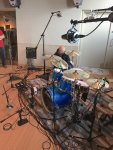Hey guys !
Not afraid to sound like a huge noob here, I have no pretention when it comes to sound engeneering, though I am a patient dude and always end up with a more than ok sound. Plus, studios in my hometown seem to work more with hip hop or guitar/vocals artists. So we are trying to become more self-reliant in the sound department (mics and placement, interface, etc).
I had an ok kick mic and 2 cheapo small diaphragm cardioid condenser OH (pencil mics). We have a UR44 interface. I play one up two down 2 crash 1 ride and 1 effect, sometimes adding a left snare.
I used the recordman method to start (an OH +/- 2 stick length above snare and the other equidistant to snare over right shoulder) and move right OH around to adapt to the situation. We tinkered quite a bit in the last year with the setup.
Now I added an sm57 just for the snare which is a great overall improvement.
Questions :
1- Should I still point one oh directly towards the snare (back, front, etc.) or is there a common technique to start with ?
2- can i use the other oh pencil mic pointing upwards equidistant to the other oh in a john glyns fashion?
I know it's all trial and error, but just a couple of tips or do's and Donts would be apreciated.
Any suggestion can help including ones I can't even fathom at this point, thanks in advance!
Not afraid to sound like a huge noob here, I have no pretention when it comes to sound engeneering, though I am a patient dude and always end up with a more than ok sound. Plus, studios in my hometown seem to work more with hip hop or guitar/vocals artists. So we are trying to become more self-reliant in the sound department (mics and placement, interface, etc).
I had an ok kick mic and 2 cheapo small diaphragm cardioid condenser OH (pencil mics). We have a UR44 interface. I play one up two down 2 crash 1 ride and 1 effect, sometimes adding a left snare.
I used the recordman method to start (an OH +/- 2 stick length above snare and the other equidistant to snare over right shoulder) and move right OH around to adapt to the situation. We tinkered quite a bit in the last year with the setup.
Now I added an sm57 just for the snare which is a great overall improvement.
Questions :
1- Should I still point one oh directly towards the snare (back, front, etc.) or is there a common technique to start with ?
2- can i use the other oh pencil mic pointing upwards equidistant to the other oh in a john glyns fashion?
I know it's all trial and error, but just a couple of tips or do's and Donts would be apreciated.
Any suggestion can help including ones I can't even fathom at this point, thanks in advance!


